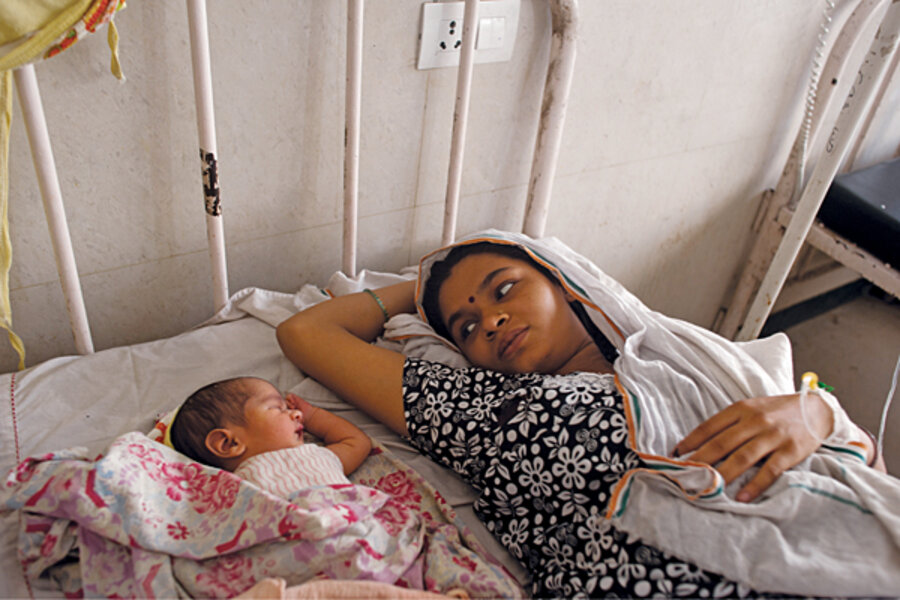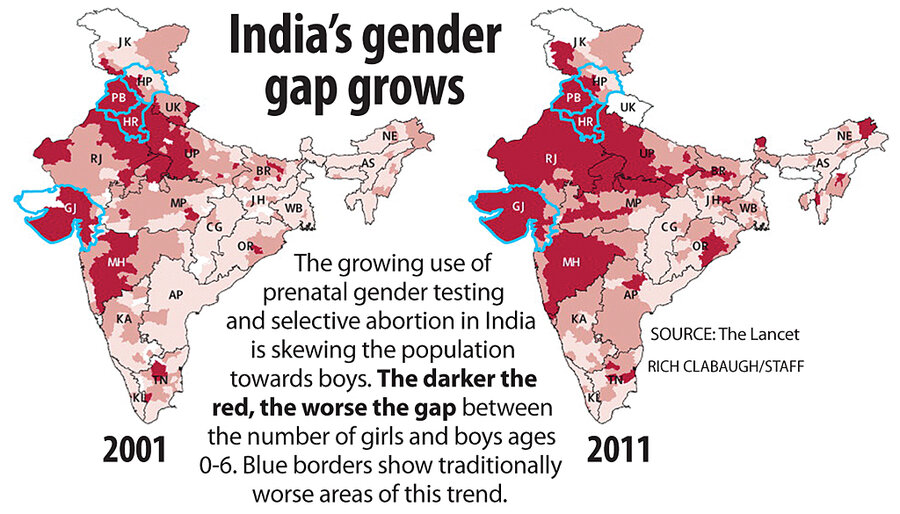India tries cash incentives to save its girls
Loading...
| Mullahera, India
Not long ago, Mullahera, a village on what was then the outskirts of New Delhi, was the kind of place where families wanted a boy. Their reasoning was simple: A boy could inherit farmland, work the fields, and provide space in his future home for elderly parents.
But in January, local officials came to Mullahera – now nestled alongside the glass towers of the ever-expanding city – to present residents with a significant gift: a check for 100,000 rupees, or $2,200, for producing more girl than boy births.
With selective abortion of girls in India worse than ever, the state of Haryana – which has one of the worst birth ratios – has started to reward the village in each district that is defying the odds.
Haryana is not the only state trying such a tactic. The federal and state governments in India are testing cash incentives to encourage pregnant women to not screen for gender and abort their girls – a problem that grows with wealth and access to ultrasound technology. But while the programs offer stories of progress, activists say they distract from serious crackdowns on illegal gender testing.
"We should give as many resources to girls and women [as we can]. I have no problem with that. But implement the law," says Sabu George, a campaigner against selective-sex abortion in India.
Mullahera showed a birth ratio of 1,188 girls to 1,000 boys in 2009. That's way ahead of the latest figures for the district (an 853 to 1,000 ratio), the state (an 877 to 1,000 ratio), and India (a 914 to 1,000 ratio).
Some of the 5,310 residents say that urbanization has improved the image of girls. "Now, with education, the work profile has changed," says Begraj Yadav, a local politician. "Girls are better office workers."
The village chief, Manoj Yadav, says he frequently tells parents about women who hold government jobs, like their district commissioner. Even in sports, girls inspire: A Haryana woman climbed Mt. Everest.
In one local home, Lakshmi Yadav lives with her two adult daughters, who each have one daughter. None of the women have sons, and they aren't troubled by it.
"Do you think girls don't serve their parents when they get old? Girls are better any day," says Mrs. Yadav. Villagers point out that the tradition of a son living with elderly parents is fading. Yadav concedes a downside to girls: having to pay a dowry to marry them. "Look at the prices! We console ourselves saying this is enough [children] for us – even one girl is enough."
What the numbers say
The idea that urbanization is ending a preference for boys does not show up in national data, however. In fact, urban areas and wealthier regions have the worst ratios. That's because of access to ultrasounds, says Prabhat Jha, at the Center for Global Health Research in Toronto. "The preference for boys is pretty similar across India, rich areas or poor areas, north or south, educated or uneducated," he says. But "houses that have the money and means to get tested and abort girls are going to be the ones using [ultrasounds]."
The 2011 Census figures show the problem has only deepened and spread across most of the country. Dr. Jha calculated that up to 12 million girls have been aborted over the past 30 years in India. He says the desire for smaller families puts added pressure on parents of one daughter to make sure their next child is a boy.
Haryana offers $550 to families who have a second girl. But for all the incentive schemes put in place over the past decade, the 2011 Census saw only a tiny improvement in the state's ratio, which was more than offset by rapid falls in previously unaffected states like Kashmir.
"Whatever measures that have been put in over the last 40 years have not had any impact," said G.K. Pillai, India's home secretary, after the 2011 Census.
Hurdles yet
The flaws in the village prize program are numerous. It includes villages as small as 5,000 people. In 2009, there were only 69 boys and 82 girls born in Mullahera.
"With such small numbers, large fluctuations in the sex-ratio over time can exist just due to chance," says Sylvie Dubuc, a population researcher at the Oxford Institute of Social Policy.
Indeed, in 2010, the ratio evened out with 70 boys and 69 girls born.
Second, the village was not aware of the award before – and even after – winning. A third concern with cash rewards is their potential for abuse. Two different officials in Mullahera claimed to have possession of the 100,000 rupees.
A Haryana official also says that the winners look fudged. "I have noticed that, according to the statistics, the villages with better girl-child ratios are not given the prize. So there has to be some manipulation in choosing villages," says Praveen Kumar Singh, deputy director of monitoring and evaluation in the state department of health. He declined to give supporting data.
Greater transparency could help girl-child campaigners. "The release of more disaggregated census data down to a village level ... would actually create local debate, saying, 'Look, we are one of the worst offenders,' " says Jha.
Education campaigns
The award has inspired the four female health workers in Mullahera who feel their education campaigns and doctor visits with pregnant women have helped.
The program is designed to energize the community. "It's not intended to convince the parents of the child. It's the community many times which also participates in the decisionmaking," says state financial commissioner Rajan Gupta. He claims such programs helped Haryana improve its ratio.
For Mr. George, the activist, Haryana has nothing to brag about, with six of India's 10 worst districts for birth ratios. The problem – which he calls a "genocide" – is deepening. He argues that the Pre-Natal Diagnostic Techniques Act of 1994, which punishes doctors for performing sex determinations, is the untried solution. "We can count on our own hands the number of districts where the law has been implemented because everywhere the doctors are so powerful," says George.






